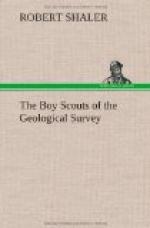“I shall read only two more brief paragraphs:”
“’Washington’s success as a surveyor for Lord Fairfax called the attention of the Virginia authorities to him and to the unusual accuracy of his surveys. As a consequence, he was appointed public surveyor, deriving a discipline therefrom which was of great service to him in his later career. By making him an able civil engineer, it laid the foundation of his future eminence in a military capacity. And by making him known to the principal landholders of the State, it led to his appointment, at the age of nineteen, to the office of adjutant-general, with the rank of major. This gave him the charge of a district, with the duty of exercising the militia, inspecting their arms, and superintending their discipline.’”
“That is all, boys,” concluded the Scout Master, rising and closing the volume. “But as we take up our course in surveying, with the additional interest of its geological significance, we may like to remember that we are following in the footsteps of no less a man than George Washington!”
CHAPTER XIII
THE RESULT OF THE SURVEYS
Promptly at nine o’clock on the following Monday morning, a clean-cut, well-knit, strong-featured young man stood before an eager-faced group of khaki-clad scouts in Pioneer Camp.
The businesslike attitude of the young instructor, Ransom Thayer, was reflected in the appearance of the boys; and from the first crisp greeting of Mr. Thayer to his curt dismissal an hour and a half later, the interest and attention of his auditors never wavered.
His first lesson emphasized the historical phase of geology; and as he talked and pointed here and there in illustration, it seemed to the boys that every stone and boulder and pebble and overhanging cliff responded with the story of its life. This crevice, that oblique angle, this smooth indentation, that rough mass,—–each marking had its significant meaning to the enthusiastic leader.
Walter Osborne said to Blake after “school” was over for the morning, “I have always felt as though the trees of the forest were alive, but now it seems to me that every rock is a breathing, changing, growing thing, too.”
That afternoon Mr. Thayer led his troop afield and showed them other volumes of rock history,—–how this proved that in ages past water had forced a channel through the hills; how that gave evidences of internal disturbances, of molten masses, of slowly cooling and hardening structure.
Many of the boys had had courses in textbook geology and had gathered “specimens,” but this man made all these things new and wonderful and fascinatingly interesting.
Day after day passed and still the enthusiasm grew. “Dry facts” wore absorbed unconsciously; angular diagrams of mathematical relations appeared on the big blackboard so clearly and concisely that even Shorty Mcneil ceased to dread the problems; hours were cheerfully spent at the big mess table in making out tabulated reports and drawing neat maps; and many more hours were spent with compasses and levels, telescopes and heliotropes measuring and judging distances and noting results on the hills and by the lake near camp.




